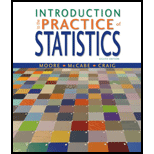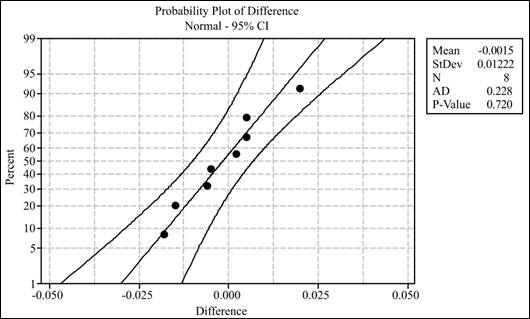
Concept explainers
(a)
Section 1:
To find: The difference between the TBBMC recorded for Operator 1 and the TBBMC for Operator 2.
(a)
Section 1:
Answer to Problem 43E
Solution: The table for difference is as follows:
Operator 1 |
Operator 2 |
Difference |
1.328 |
1.323 |
0.005 |
1.342 |
1.322 |
0.02 |
1.075 |
1.073 |
0.002 |
1.228 |
1.233 |
−0.005 |
0.939 |
0.934 |
0.005 |
1.004 |
1.019 |
−0.015 |
1.178 |
1.184 |
−0.006 |
1.286 |
1.304 |
−0.018 |
Explanation of Solution
Calculation:
To calculate the difference, follow the below mentioned steps in Minitab:
Step 1: Enter the variable name as “Operator 1” in column C1 and enter the data for “Operator 1” and enter the variable name as “Operator 2” in column C2 and enter the data for “Operator 2.”
Step 2: Enter variable name as “Difference” in column C3.
Step 3: Go to
Step 4: In the dialog box that appears, select “Difference” in “Store result in variable.”
Step 5: Enter “Operator 1”-“Operator 2” in “Expression.” Click on “Ok” on the dialog box.
From Minitab result, the table for difference is as follows:
Operator 1 |
Operator 2 |
Difference |
1.328 |
1.323 |
0.005 |
1.342 |
1.322 |
0.02 |
1.075 |
1.073 |
0.002 |
1.228 |
1.233 |
−0.005 |
0.939 |
0.934 |
0.005 |
1.004 |
1.019 |
−0.015 |
1.178 |
1.184 |
−0.006 |
1.286 |
1.304 |
−0.018 |
Interpretation: It is clear from the table that the
Section 2:
To test: Whether t- methods can be used or not.
Section 2:
Answer to Problem 43E
Solution: The t- method can be used.
Explanation of Solution
Calculation:
To determine if the t methods can be used or not, a probability plot is drawn in Minitab by following the below mentioned steps:
Step 1: Follow steps 1 and 2 similar to that in Section 1.
Step 2: Go to “Graph” option and click on “Probability Plot.” In the dialog box that appears, select “Single” and click on OK.
Step 3: Then enter the name of the column containing the data of the differences in the “Graph variables” field and click on OK.
The following probability plot is obtained:

Conclusion: The probability plot shows that the data is approximately normal as all the data points fall within the range and, hence, it is appropriate to use t procedures.
(b)
To test: The significance of the difference between the means of two operators.
(b)
Answer to Problem 43E
Solution: The test statistic value is
Explanation of Solution
Calculation:
To test the null hypothesis, follow the below mentioned steps in Minitab:
Step 1: Follow the Steps 1 to 5 performed in section 1 of part (a).
Step 2: Go to
Step 3: In the dialogue box that appears, select samples in columns.
Step 4: Enter “Operator 1” under the field marked as “First sample” and “Operator 2” under the field marked as “Second sample.”
Step 5: In the dialogue box that appears, Click on “Option.” Enter 95.0 in the field of Confidence interval, 0.0 in “Test mean,” and “not equal” in “Alternative.”
From Minitab results, the value of test statistic is
D.F = n –.
D.F = 8 –.
D.F =.
Conclusion: If the level of significance is 5% then as the p- value is greater than 0.05 the null hypothesis will not be rejected and it is concluded that the two means do not differ significantly at 95% confidence level.
(c)
To find: The confidence interval for difference.
(c)
Answer to Problem 43E
Solution: The required confidence interval is
Explanation of Solution
Calculation: To compute the confidence interval, follow the below mentioned steps in Minitab:
Step 1: Follow the steps 1 to 5 performed in section 1 of part (a).
Step 2: Go to
Step 3: In the dialogue box that appears, select samples in columns.
Step 4: Enter “Operator 1” under the field marked as “First sample” and “Operator 2” under the field marked as “Second sample.”
Step 5: In the dialogue box that appears, Click on “Option.” Enter 95.0 in the field of Confidence interval, 0.0 in “Test mean,” and “not equal” in “Alternative.”
From the Minitab results, the confidence interval is
Interpretation: The confidence interval denotes that the differences recorded will lie in between −0.01172 and 0.00872 with a possible chance of 5% error.
(d)
The validity of the results if the samples are not random.
(d)
Answer to Problem 43E
Solution: The testing results and the confidence interval may not be valid if the samples are non-random.
Explanation of Solution
Want to see more full solutions like this?
Chapter 7 Solutions
Introduction to the Practice of Statistics: w/CrunchIt/EESEE Access Card
- 2. Hypothesis Testing - Two Sample Means A nutritionist is investigating the effect of two different diet programs, A and B, on weight loss. Two independent samples of adults were randomly assigned to each diet for 12 weeks. The weight losses (in kg) are normally distributed. Sample A: n = 35, 4.8, s = 1.2 Sample B: n=40, 4.3, 8 = 1.0 Questions: a) State the null and alternative hypotheses to test whether there is a significant difference in mean weight loss between the two diet programs. b) Perform a hypothesis test at the 5% significance level and interpret the result. c) Compute a 95% confidence interval for the difference in means and interpret it. d) Discuss assumptions of this test and explain how violations of these assumptions could impact the results.arrow_forward1. Sampling Distribution and the Central Limit Theorem A company produces batteries with a mean lifetime of 300 hours and a standard deviation of 50 hours. The lifetimes are not normally distributed—they are right-skewed due to some batteries lasting unusually long. Suppose a quality control analyst selects a random sample of 64 batteries from a large production batch. Questions: a) Explain whether the distribution of sample means will be approximately normal. Justify your answer using the Central Limit Theorem. b) Compute the mean and standard deviation of the sampling distribution of the sample mean. c) What is the probability that the sample mean lifetime of the 64 batteries exceeds 310 hours? d) Discuss how the sample size affects the shape and variability of the sampling distribution.arrow_forwardA biologist is investigating the effect of potential plant hormones by treating 20 stem segments. At the end of the observation period he computes the following length averages: Compound X = 1.18 Compound Y = 1.17 Based on these mean values he concludes that there are no treatment differences. 1) Are you satisfied with his conclusion? Why or why not? 2) If he asked you for help in analyzing these data, what statistical method would you suggest that he use to come to a meaningful conclusion about his data and why? 3) Are there any other questions you would ask him regarding his experiment, data collection, and analysis methods?arrow_forward
- Businessarrow_forwardWhat is the solution and answer to question?arrow_forwardTo: [Boss's Name] From: Nathaniel D Sain Date: 4/5/2025 Subject: Decision Analysis for Business Scenario Introduction to the Business Scenario Our delivery services business has been experiencing steady growth, leading to an increased demand for faster and more efficient deliveries. To meet this demand, we must decide on the best strategy to expand our fleet. The three possible alternatives under consideration are purchasing new delivery vehicles, leasing vehicles, or partnering with third-party drivers. The decision must account for various external factors, including fuel price fluctuations, demand stability, and competition growth, which we categorize as the states of nature. Each alternative presents unique advantages and challenges, and our goal is to select the most viable option using a structured decision-making approach. Alternatives and States of Nature The three alternatives for fleet expansion were chosen based on their cost implications, operational efficiency, and…arrow_forward
- The following ordered data list shows the data speeds for cell phones used by a telephone company at an airport: A. Calculate the Measures of Central Tendency from the ungrouped data list. B. Group the data in an appropriate frequency table. C. Calculate the Measures of Central Tendency using the table in point B. 0.8 1.4 1.8 1.9 3.2 3.6 4.5 4.5 4.6 6.2 6.5 7.7 7.9 9.9 10.2 10.3 10.9 11.1 11.1 11.6 11.8 12.0 13.1 13.5 13.7 14.1 14.2 14.7 15.0 15.1 15.5 15.8 16.0 17.5 18.2 20.2 21.1 21.5 22.2 22.4 23.1 24.5 25.7 28.5 34.6 38.5 43.0 55.6 71.3 77.8arrow_forwardII Consider the following data matrix X: X1 X2 0.5 0.4 0.2 0.5 0.5 0.5 10.3 10 10.1 10.4 10.1 10.5 What will the resulting clusters be when using the k-Means method with k = 2. In your own words, explain why this result is indeed expected, i.e. why this clustering minimises the ESS map.arrow_forwardwhy the answer is 3 and 10?arrow_forward
 MATLAB: An Introduction with ApplicationsStatisticsISBN:9781119256830Author:Amos GilatPublisher:John Wiley & Sons Inc
MATLAB: An Introduction with ApplicationsStatisticsISBN:9781119256830Author:Amos GilatPublisher:John Wiley & Sons Inc Probability and Statistics for Engineering and th...StatisticsISBN:9781305251809Author:Jay L. DevorePublisher:Cengage Learning
Probability and Statistics for Engineering and th...StatisticsISBN:9781305251809Author:Jay L. DevorePublisher:Cengage Learning Statistics for The Behavioral Sciences (MindTap C...StatisticsISBN:9781305504912Author:Frederick J Gravetter, Larry B. WallnauPublisher:Cengage Learning
Statistics for The Behavioral Sciences (MindTap C...StatisticsISBN:9781305504912Author:Frederick J Gravetter, Larry B. WallnauPublisher:Cengage Learning Elementary Statistics: Picturing the World (7th E...StatisticsISBN:9780134683416Author:Ron Larson, Betsy FarberPublisher:PEARSON
Elementary Statistics: Picturing the World (7th E...StatisticsISBN:9780134683416Author:Ron Larson, Betsy FarberPublisher:PEARSON The Basic Practice of StatisticsStatisticsISBN:9781319042578Author:David S. Moore, William I. Notz, Michael A. FlignerPublisher:W. H. Freeman
The Basic Practice of StatisticsStatisticsISBN:9781319042578Author:David S. Moore, William I. Notz, Michael A. FlignerPublisher:W. H. Freeman Introduction to the Practice of StatisticsStatisticsISBN:9781319013387Author:David S. Moore, George P. McCabe, Bruce A. CraigPublisher:W. H. Freeman
Introduction to the Practice of StatisticsStatisticsISBN:9781319013387Author:David S. Moore, George P. McCabe, Bruce A. CraigPublisher:W. H. Freeman





